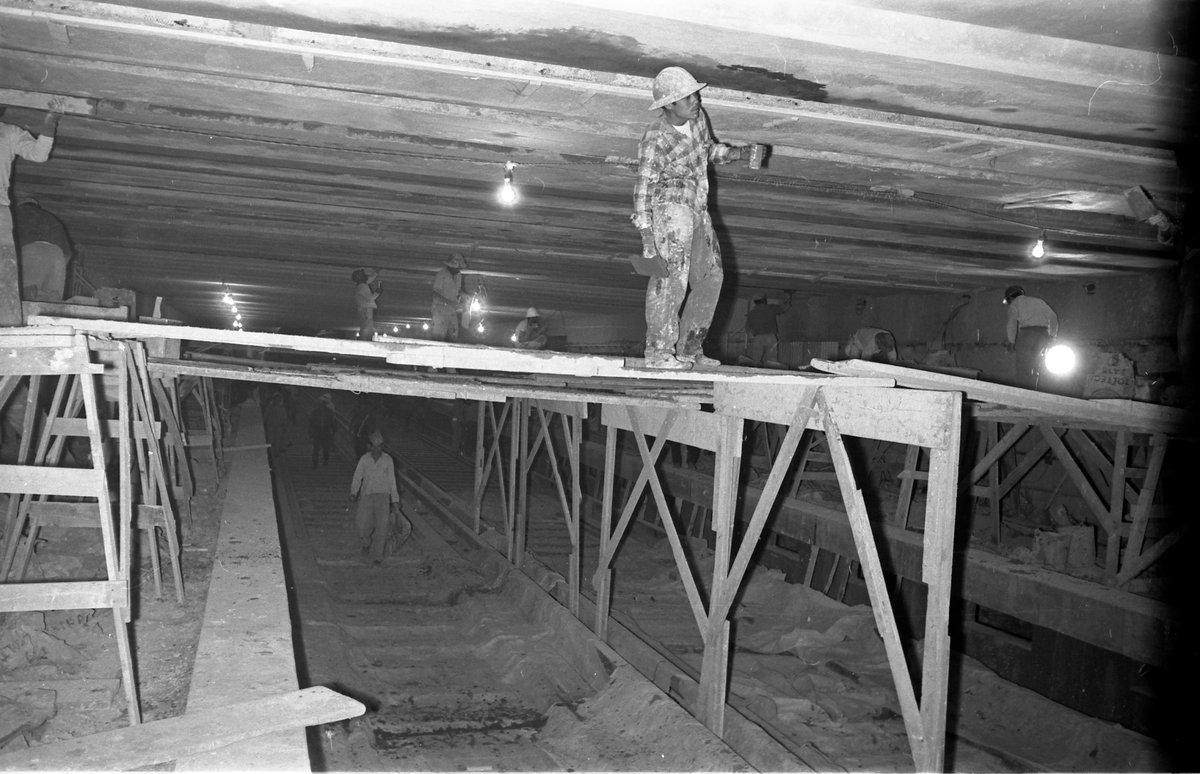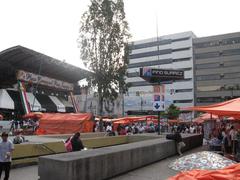
Pino Suárez Mexico City Visiting Hours, Tickets, and Historical Sites Guide
Date: 14/06/2025
Introduction: Pino Suárez’s Unique Window into Mexico City’s Heritage
Pino Suárez, located at the intersection of Mexico City’s vibrant urban life and its profound historical roots, offers a singular experience where ancient Mexica legacy and modern urban development converge. Most notably, the Temple of Ehécatl—a 650-year-old Mexica pyramid dedicated to the god of wind—is seamlessly integrated into the Pino Suárez Metro station, making it one of the most democratized and accessible archaeological sites in the city. With free access during Metro operating hours and millions of daily commuters and visitors, Pino Suárez is a living testament to Mexico City’s ability to honor its layered past within the framework of contemporary life (Mexico Travel & Leisure).
Beyond this archaeological treasure, the neighborhood is rich with colonial architecture, vibrant markets, and proximity to iconic landmarks such as the Zócalo, Palacio Nacional, and Catedral Metropolitana (Lonely Planet). This guide provides you with thorough information on visiting hours, tickets, accessibility, transportation, cultural etiquette, and essential tips to ensure a rewarding and insightful experience.
Contents
- Pre-Hispanic Foundations and the Temple of Ehécatl
- Colonial and Modern Transformations
- Rediscovery and Archaeological Preservation
- Cultural and Historical Significance
- Essential Visitor Information
- Location and Access
- Visiting Hours and Tickets
- On-Site Experience and Photography
- Accessibility
- Special Events and Tours
- Nearby Attractions
- Practical Tips
- Visitor Impact and Conservation
- Cultural Insights and Local Context
- Frequently Asked Questions (FAQ)
- Conclusion
- References and Further Resources
Pre-Hispanic Foundations and the Temple of Ehécatl
Beneath the streets of Mexico City’s Centro Histórico lies the Temple of Ehécatl, an extraordinary relic of the Mexica (Aztec) civilization. Dating to approximately 1400 CE, the temple is dedicated to the wind god Ehécatl, whose circular structure reflects the dynamism of wind and cycles in Mexica cosmology. Unlike the grand Templo Mayor, this smaller temple served a specialized role in rituals related to wind and agricultural fertility. Its unique preservation inside the Pino Suárez Metro station means it is viewed by millions each year—making it one of the world’s most accessible archaeological sites (Mexico Travel & Leisure).
Colonial and Modern Transformations
Post-conquest, Spanish colonizers dramatically reshaped Tenochtitlan, repurposing indigenous temples for colonial constructions. The Pino Suárez area was absorbed into the colonial grid, with its ancient past largely obscured by new streets and buildings. Centuries later, the construction of the Metro system in the 1960s led to the rediscovery of the Temple of Ehécatl, prompting archaeological rescue and preservation efforts. Today, Pino Suárez’s urban fabric is a blend of pre-Hispanic remnants, colonial grandeur, and modern commercial energy, illustrated by nearby landmarks such as the Museo de la Ciudad de México and the bustling Plaza Comercial Pino Suárez (Lonely Planet).
Rediscovery and Archaeological Preservation
The Temple of Ehécatl was unearthed during Metro construction in the late 1960s. Archaeologists from INAH (Instituto Nacional de Antropología e Historia) undertook careful excavation and integrated the site into the station’s design. Today, the temple is protected by glass and accompanied by interpretive panels, educating the public in both Spanish and English. This model of in situ preservation within a functional urban space is unique, highlighting Mexico City’s commitment to making heritage accessible (Mexico Travel & Leisure).
Cultural and Historical Significance
The Temple of Ehécatl’s presence in a busy metro station is emblematic of Mexico City’s capacity to harmonize its ancient roots with modern life. It offers an everyday encounter with history for both locals and visitors, reinforcing cultural memory and the significance of conserving urban archaeological sites. The site is a symbol of resilience—of both the city and its living heritage.
Essential Visitor Information
Location and Access
Pino Suárez is centrally situated in the Centro Histórico, at the intersection of Metro Lines 1 and 2. The temple is located within the station itself, making it highly accessible via public transportation. The area is also within easy walking distance to the Zócalo, Palacio Nacional, and Museo de la Ciudad de México (Mexico Travel & Leisure; Lonely Planet).
Visiting Hours and Tickets
- Temple of Ehécatl: Accessible daily during Metro operating hours (5:00 AM to midnight). No separate admission fee; access is included with your Metro fare.
- Museo de la Ciudad de México: Open Tuesday–Sunday, 10:00 AM to 5:00 PM. Admission: 70 MXN (discounts for students and seniors).
On-Site Experience and Photography
The temple is displayed in a glass-enclosed, well-lit area with informative signage. Photography is permitted; visitors are encouraged to be mindful of commuter flow and respect the site. Visiting during off-peak hours (early morning or late evening) allows for a quieter, more contemplative experience.
Accessibility
Pino Suárez Metro station offers elevators, ramps, and tactile flooring, providing good accessibility for travelers with mobility or visual challenges. The busy environment may require assistance for those needing extra support.
Special Events and Tours
While regular guided tours of the Temple of Ehécatl are not standard, occasional special programs by INAH or city institutions may feature the site. Check the INAH website or the Mexico City tourism portal for updates.
Nearby Attractions
- Museo de la Ciudad de México: 18th-century baroque palace with exhibits on city history.
- Zócalo and National Palace: The city’s main square and seat of government.
- Catedral Metropolitana: The largest cathedral in the Americas.
- Mercado José María Pino Suárez: Traditional market open daily, 7:00 AM–6:00 PM, with 200+ vendors and authentic local cuisine (Mercado José María Pino Suárez).
Practical Tips
- Language: Most signage is in Spanish; consider a translation app for deeper understanding.
- Safety: Exercise standard precautions—watch valuables, especially during peak hours.
- Transportation: Metro is the fastest way to reach Pino Suárez; authorized taxis and ride-sharing apps are also available (mexicocitystreets.com; gov.uk).
- Market Etiquette: Tipping attendants (cerillitos) 5 pesos is customary; bring reusable bags due to the city’s ban on plastic.
Visitor Impact and Conservation
The high daily traffic at Pino Suárez underscores the importance of ongoing conservation. INAH regularly monitors the site, balancing public access with preservation. Visitors are urged to respect guidelines and help ensure this unique archaeological site remains accessible for future generations (Mexico Travel & Leisure).
Cultural Insights and Local Context
Pino Suárez exemplifies the coexistence of ancient and modern Mexico City. Its markets, plazas, and preserved ruins create a vibrant urban tapestry, reflecting centuries of resilience and renewal. The area’s commercial vitality, historic architecture, and everyday encounters with living history make it a microcosm of the Mexican capital’s broader narrative.
Frequently Asked Questions (FAQ)
Q: What are the visiting hours for the Temple of Ehécatl at Pino Suárez?
A: Daily, 5:00 AM–midnight, in line with Metro operating hours.
Q: Is there an admission fee for the Temple of Ehécatl?
A: No; entry is included with your Metro ticket.
Q: Is the site accessible for people with disabilities?
A: Yes, the station includes elevators, ramps, and tactile flooring, though assistance may be helpful during busy times.
Q: Are guided tours available?
A: Not regularly for the temple, but special programs may occur. Check official tourism channels for updates.
Q: Is it safe to visit Pino Suárez?
A: Yes, especially during the day. Follow standard city precautions, particularly in crowded areas.
Conclusion
Pino Suárez is more than a transit point; it is a vibrant crossroads of history, culture, and daily life. Its integration of pre-Hispanic heritage, colonial architecture, bustling markets, and contemporary transit infrastructure offers a uniquely immersive experience in Mexico City’s historic heart. Plan your visit for off-peak hours, explore nearby attractions, and engage with the local community to fully appreciate this dynamic neighborhood.
For detailed updates, guided tours, and cultural events, consult the INAH website and the Mexico City tourism portal. Enhance your experience with the Audiala app, offering curated cultural guides and interactive maps.
References and Further Resources
- Mexico Travel & Leisure: Archaeological Sites in Mexico City
- Lonely Planet: Museo de la Ciudad de México
- Mexico City Metro Transportation Guide
- Mexico City Tourism Portal
- INAH Official Website
- Mercado José María Pino Suárez
- Museos de México: Museo de la Ciudad de México
- Wikipedia: Pino Suárez Metro Station
- Mental Floss: Must-Visit Metro Stops
- mztrealestate.com: Mercado Pino Suarez
- Mexico City Metro Information
- Centro Histórico Visitor Guide
- gov.uk: Mexico City Safety and Security
- northernlauren.com: Mexico City Metro Guide
- asherfergusson.com: Mexico Safety Tips
- travellersworldwide.com: Best Time to Visit Mexico City
- MexicoCity.com
- Virtual Mexico City Tours
- Aliki Travel Blog
- Travel Books Food: Mexico City Travel Tips











































































































































































